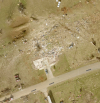CheeselandSkies
Member
A key breakpoint exists between how the legacy Fujita (F) scale and the EF scale handle the complete
destruction and sweeping away of single-family homes, with standard “well-constructed” homes
being swept away constituting F5 damage on the F scale but only EF4 damage on the EF scale.
I'm glad someone official finally admitted this. When the EF-scale was being adopted, I recall being told in multiple publications that the scales were intended to be applied in the same way (what was rated F5 before, should be rated EF5 now and so on down the scale); just that the new scale with its detailed DIs would provide some specificity to the rather vague and subjective damage descriptors in the old scale, thus giving surveyors more confidence and alleviating the "La Plata syndrome" which had become rampant.
It was a lie.
However, it's refreshing to see some in the "official" tornado research community finally taking a serious look at this. Perhaps it's been going on too long, and starting to creep down the scale as well (such that the determination between EF3 and EF4 has in some cases become as controversial as EF4-EF5 was not too long ago) that it can no longer be dismissed as Twitter weenies wanting every tornado to be rated higher.
Last edited:















